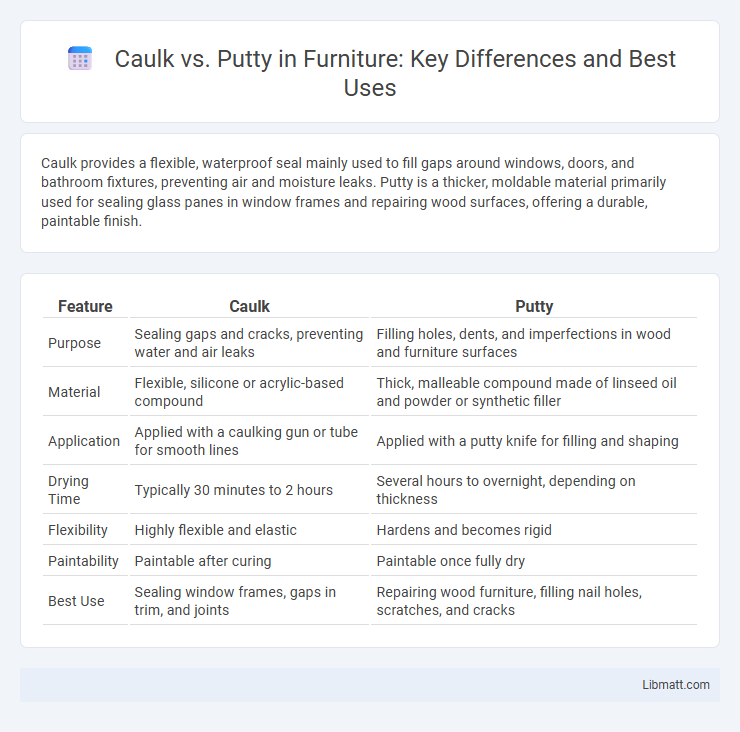Caulk provides a flexible, waterproof seal mainly used to fill gaps around windows, doors, and bathroom fixtures, preventing air and moisture leaks. Putty is a thicker, moldable material primarily used for sealing glass panes in window frames and repairing wood surfaces, offering a durable, paintable finish.
Table of Comparison
| Feature | Caulk | Putty |
|---|---|---|
| Purpose | Sealing gaps and cracks, preventing water and air leaks | Filling holes, dents, and imperfections in wood and furniture surfaces |
| Material | Flexible, silicone or acrylic-based compound | Thick, malleable compound made of linseed oil and powder or synthetic filler |
| Application | Applied with a caulking gun or tube for smooth lines | Applied with a putty knife for filling and shaping |
| Drying Time | Typically 30 minutes to 2 hours | Several hours to overnight, depending on thickness |
| Flexibility | Highly flexible and elastic | Hardens and becomes rigid |
| Paintability | Paintable after curing | Paintable once fully dry |
| Best Use | Sealing window frames, gaps in trim, and joints | Repairing wood furniture, filling nail holes, scratches, and cracks |
Introduction to Caulk and Putty
Caulk is a flexible sealing material used to fill gaps and cracks around windows, doors, and other joints to prevent air and water infiltration. Putty is a malleable substance primarily used for filling holes or cracks in wood or glass, often before painting or glazing. Both serve to improve structural integrity and aesthetics but differ in composition and application.
What is Caulk?
Caulk is a flexible sealing material commonly used to fill gaps and cracks in joints around windows, doors, and plumbing fixtures to prevent water, air, and insect infiltration. It is typically made from silicone, latex, or acrylic and can easily be smoothed for a clean, waterproof finish. When choosing caulk, consider your specific project needs, as some types are designed for interior use while others are formulated to withstand outdoor elements.
What is Putty?
Putty is a malleable substance primarily used to fill small holes, cracks, and gaps in surfaces such as wood, glass, or metal. It is commonly composed of a mixture of powdered chalk and linseed oil, providing a smooth and durable finish after application. Your choice between putty and caulk depends on the surface and purpose, as putty is ideal for sealing windows and minor repairs where flexibility is less critical.
Key Differences Between Caulk and Putty
Caulk is a flexible, water-resistant material designed to seal gaps and joints, making it ideal for areas exposed to movement or moisture, while putty is a harder, moldable substance primarily used to fill holes or cracks in wood or metal surfaces. Caulk typically comes in tubes and cures to form a rubbery seal, whereas putty remains soft or hardens slowly without shrinking. Your choice between caulk and putty depends on whether you need a durable, elastic seal or a solid filler for repairs.
Common Uses for Caulk
Caulk is commonly used to seal joints and gaps around windows, doors, bathtubs, and sinks to prevent air and water leaks. Its flexibility makes it ideal for areas subject to movement or expansion. Caulk types include acrylic, silicone, and latex, each suited for different surfaces and environmental conditions.
Common Uses for Putty
Putty is commonly used for filling small holes, cracks, and imperfections in wood, metal, and glass surfaces to create a smooth, paintable finish. It is ideal for repairing window panes, securing glass in frames, and sealing minor gaps before painting or finishing. Unlike caulk, putty remains soft and pliable or hardens depending on its formulation but is typically not flexible enough for areas subject to expansion or movement.
Pros and Cons of Caulk
Caulk offers excellent flexibility and water resistance, making it ideal for sealing gaps around windows, doors, and bathrooms, preventing air and moisture infiltration. It adheres well to a variety of surfaces and is easy to apply and paint over, but may shrink or crack over time, requiring reapplication. Your choice of caulk should consider factors like indoor vs. outdoor use, exposure to temperature changes, and the need for durability versus ease of repair.
Pros and Cons of Putty
Putty offers excellent flexibility and is ideal for filling small gaps and cracks in wood or metal surfaces, making it a preferred choice for window glazing or minor repairs. Its slow drying time allows for easy smoothing and shaping but can delay overall project completion. However, putty is less resistant to moisture and may crack or shrink over time, requiring periodic maintenance compared to more resilient materials like silicone caulk.
How to Choose Between Caulk and Putty
Choose caulk when sealing gaps or joints that require flexibility and waterproofing, such as around windows, doors, or bathtubs. Opt for putty when filling holes, cracks, or blemishes on wood or metal surfaces that will be painted or stained, as it provides a hard, sculptable finish. Your decision depends on the surface type, expected movement, and exposure to moisture for a durable and effective repair.
Caulk vs Putty: Which is Best for Your Project?
Caulk is flexible and ideal for sealing gaps around windows, doors, and bathrooms, preventing air and water leaks, while putty is best suited for filling holes and smoothing surfaces, particularly in woodwork and glazing. Your choice depends on the project's requirements for flexibility, durability, and surface compatibility. For long-lasting seals and weather resistance, caulk outperforms putty, but for small repairs and finishing touches, putty is the superior option.
caulk vs putty Infographic

 libmatt.com
libmatt.com